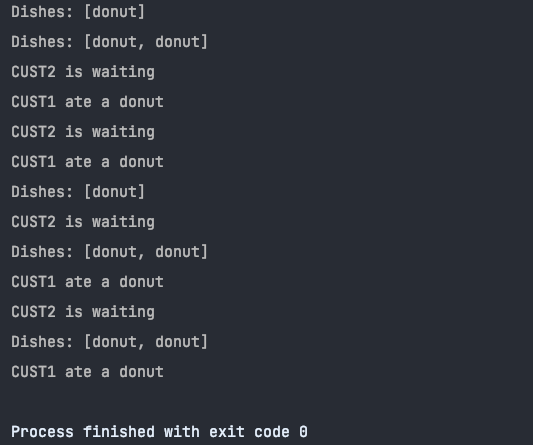쓰레드의 동기화(synchronization)
- 멀티 쓰레드 프로세스에서는 다른 쓰레드의 작업에 영향을 미칠 수 있다.
- 진행중인 작업이 다른 쓰레드에게 간섭받지 않게 하려면, '동기화'가 필요하다.
쓰레드의 동기화 : 한 쓰레드가 진행중인 작업을 다른 쓰레드가 간섭하지 못하게 막는 것
- 동기화하려면, 간섭받지 않아야 하는 문장들을
임계 영역으로 설정(여러 문장 하나로 묶기) - 임계 영역은 락(lock)을 얻은 단 하나의 쓰레드만 출입가능 (객체 1개에 락 1개)
synchronized를 이용한 동기화
-
synchronized로 임계영역(lock이 걸리는 영역)을 설정하는 방법 2가지
-
- 메서드 전체를 임계 영역으로 지정
public synchronized void calcSum(){
// ...
}
- 메서드 전체를 임계 영역으로 지정
-
- 특정한 영역을 임계 영역으로 지정
synchronized(객체의 참조변수){
// ...
}
- 특정한 영역을 임계 영역으로 지정
-
임계 영역은 한 번에 한 쓰레드만 사용할 수 있기 때문에 영역을 최소화해야 함.
-
임계 영역이 넓을수록 성능이 떨어질 수 밖에 없다. (멀티 스레드의 장점이 동시에 여러 스레드의 작동이기 때문)
예제 코드
public class ThreadEx22 {
public static void main(String[] args) {
Runnable r = new RunabbleEx22();
new Thread(r).start();
new Thread(r).start();
}
}
class Account2 {
private int balance = 1000; // private으로 해야 동기화가 의미가 있다.
public synchronized int getBalance(){ // 사실은 읽을 때도 동기화 해줘야 함.
return balance;
}
public synchronized void withdraw(int money){ // synchronized로 메서드를 동기화
if (balance >= money) {
try{
Thread.sleep(1000);
} catch (InterruptedException e){}
balance -= money;
}
} // withdraw
}
class RunabbleEx22 implements Runnable{
Account2 acc = new Account2();
@Override
public void run() {
while(acc.getBalance() > 0){
// 100, 200, 300 중의 한 값을 임의로 선택하여 출금(withdraw)
int money = (int) (Math.random() * 3 + 1) * 100;
acc.withdraw(money);
System.out.println("balance : "+acc.getBalance());
}
}
}wait()과 notify()
- 동기화의 효율을 높이기 위해 wait(), notify()를 사용 (기다리기, 알려주기)
- Object 클래스에 정의되어 있으며, 동기화 블록 내에서만 사용할 수 있다.
wait(): 객체의 lock을 풀고 쓰레드를 해당 객체의 waiting pool에 넣는다.notify(): waiting pool에서 대기중인 쓰레드 중의 하나를 깨운다.notifyAll(): waiting pool에서 대기중인 모든 쓰레드를 깨운다.(notify로만 하는 경우보다 조금 더 공평하게 모든 스레드를 깨우고 하는게 일반적으로 좋다고 함)
wait()과 notify() 예제
-
요리사는 Table에 음식을 추가. 손님은 Table의 음식을 소비
-
요리사와 손님이 같은 객체(Table)을 공유하므로 동기화가 필요
-
[예외 1] 요리사가 Table에 요리를 추가하는 과정에 손님이 요리를 먹음
-
[예외 2] 하나 남은 요리를 손님2가 먹으려 하는데, 손님 1이 먹음
-
따라서 Table에 음식을 add, remove 하는 것에 대하여 동기화를 진행하였다.
-
[문제점] But.. 음식이 없을 때, 손님이 Table의 lock을 쥐고 안놓는다.
- 요리사가 lock을 얻지 못해서 Table에 음식을 추가할 수 없다.
-
[해결책] 음식이 없을 때, wait()으로 손님이 lock을 풀고 기다리게 하자.
- 요리사가 음식을 추가하면, notify()로 손님에게 알리자. (손님이 lock을 재획득)
예제 코드
import java.util.ArrayList;
public class Ex13_14 {
public static void main(String[] args) throws Exception {
Table table = new Table();
new Thread(new Cook(table), "Cook").start();
new Thread(new Customer(table, "donut"), "CUST1").start();
new Thread(new Customer(table, "burger"), "CUST2").start();
Thread.sleep(2000);
System.exit(0);
}
}
class Customer implements Runnable {
private Table table;
private String food;
Customer(Table table, String food) {
this.table = table;
this.food = food;
}
@Override
public void run() {
while (true) {
try {
Thread.sleep(100);
} catch (InterruptedException e){}
String name = Thread.currentThread().getName();
table.remove(food);
System.out.println(name + " ate a "+food);
}
}
}
class Cook implements Runnable {
private Table table;
Cook(Table table) {
this.table = table;
}
@Override
public void run() {
while (true) {
int idx = (int) (Math.random() * table.dishNum());
table.add(table.dishNames[idx]);
try {
Thread.sleep(100);
} catch (InterruptedException e){}
}
}
}
class Table {
String[] dishNames = {"donut", "donut", "burger"};
final int MAX_FOOD = 6;
private ArrayList<String> dishes = new ArrayList<>();
public int dishNum() {
return dishNames.length;
}
public synchronized void add(String dish) {
if(dishes.size() >= MAX_FOOD){
String name = Thread.currentThread().getName();
System.out.println(name + " is waiting");
try{
wait(); // COOK 쓰레드를 기다리게 한다.
Thread.sleep(500);
} catch (InterruptedException e){}
}
dishes.add(dish);
notify(); // 기다리고 있는 CUST를 깨우기 위함.
System.out.println("Dishes: "+dishes.toString());
}
public boolean remove(String dishName) {
synchronized (this) {
String name = Thread.currentThread().getName();
while (dishes.size() == 0) {
System.out.println(name + " is waiting");
try {
wait(); // CUST 쓰레드를 기다리게 한다.
Thread.sleep(500);
} catch (InterruptedException e){}
}
while (true) {
for(int i =0; i<dishes.size(); i++){
if(dishName.equals(dishes.get(i))){
dishes.remove(i);
notify(); // COOK을 깨우기 위함.
return true;
}
}
try{
System.out.println(name + " is waiting");
wait(); // 원하는 음식이 없는 CUST 쓰레드를 기다리게 만든다.
Thread.sleep(500);
} catch (InterruptedException e){}
}
/*return false;*/
}
}
}예제 결과

- 예제 코드의 단점 : notify시에 요리사인지 손님인지 구분이 모호함. (notify & condition에 대해 학습 해보기)

